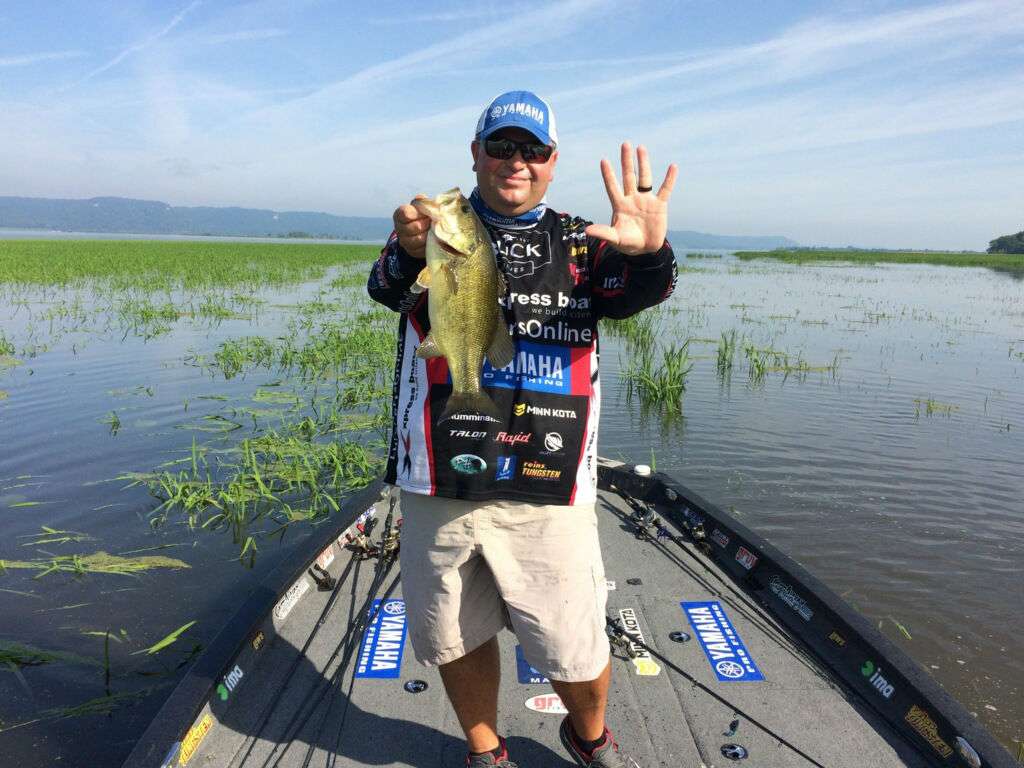
As nine-time Bassmaster Classic qualifier Bill Lowen met me at the dock at Paris Landing State Park Marina on Kentucky Lake, he noticed my surprise. Even though I’d known all year that the aluminum boat he ran on tour was rated for a 250 horsepower motor, I hadn’t fully processed that the boat’s 21-foot length and 95-inch beam made it just as big as the big glass boats that are standard issue equipment on the Elite Series.
“It’s small, isn’t it?” he joked about his Xpress X21. “Just a little old aluminum boat.”
As we cleared the no-wake zone, he punched it up past 70 miles per hour, then took it over nasty wakes that would’ve been uncomfortable in boats twice its size. We stayed dry. There was no slap of the hull on the water, no skull-tingling pounding to remind me of a bad ride for the next two weeks. He made it clear why he had no trouble running the washing machine conditions of Lake Travis or the swells of Lake Oahe, let alone the peaks and valleys of Erie’s towering waves that he’d conquered during a recent fun-fishing trip.
In fact, he said that the biggest problem is probably not where he can’t go, but rather where he can go. “Here’s what scares me,” he said. “It’s going to get me in trouble.” Meaning that at some point he’s going to venture far up a tidal creek and get landlocked when the tide goes out or skitter far back across a sea of grass and pads that preclude egress without a set of muck boots and a come-along. His Xpress might be able to float shallower than his trolling motor can operate, but he still needs 1.9 feet of water to get up on plane.
The hardest thing for a tournament fisherman at any level to do is to buck a trend. When everyone else is running the same kind of boat that may be the dominant paradigm, but it doesn’t mean it’s best for you. For many anglers, even if they knew that an aluminum boat was the best choice to put them in the winner’s circle, they’d still resist, wanting to look like the rest of the metalflaked herd.
That’s where Lowen differs. The hallmark of his career at B.A.S.S. has been a willingness to venture far back into the creeks when everyone else is out on the ledges and drops. Early in Elite Series history I remember an event at Oneida where he made a final day cut by going far up the river, into shallow areas no one else considered, to earn his second Classic berth. He did much the same at places that you would’ve expected to be outside of his comfort zone – like California’s Clear Lake – relating them to home and beating locals and veterans alike along the way.
Despite the fact that the fields at the major tours are presumed to be chock full of rugged individualists, few swim upstream, instead choosing to go with the flow. Whether it’s selecting a tour to fish, choosing a boat or deciding where to fish, there’s lots of groupthink out there, and it costs even the best anglers money and top finishes at times. Advantages right now are shrinking. Dean Rojas won that 2008 Oneida tournament because he was throwing a topwater frog when few others did. David Fritts was so dominant in the 1990s because he could find offshore fish when others couldn’t or wouldn’t – he didn’t lose that skill later on, but once side-imaging and mapping became normalized, the advantage was reduced.
The key to staying on top of the heap is to know what you do well, and then to eke out every bit of what makes you superior in that regard. It might be using a fiberglass rod or a flasher, as Fritts still does despite the fact that few of his peers do the same, or it might be using an atypical boat, as Elites like Lowen and Skylar Hamilton do. Sometimes less expensive and less technologically advanced doesn’t mean less effective.
Before we got back inside the no-wake area, Lowen promised me that he’d show me that “this boat can do whatever you want it to do, as long as you have the balls to drive it.” Then he told me to hang on, and put the boat in a tight donut, to the point that it was literally up on its side. My hand, gripping the gunnel, was suddenly in the water, but the rest of me stayed dry and centered.
I wasn’t bad in high school geometry, but I couldn’t figure out how his outboard’s prop stayed in the water with the boat seemingly at a 90 degree angle to the surface, so I asked him to do it again. This time I looked back and saw that the prop was chewing water and we were at no risk of tipping, despite frontward-looking optics that hinted otherwise. I’d have no fear about Lowen driving me in his tournament rig just about anywhere bass live. His face showed not that slightest bit of hesitation, and that put me at ease.
“If you’re in your comfort zone, you fish 100 percent better,” he explained. “When you’re in your comfort zone and things go wrong, you know how to fix it. On the other hand, if I go out on the ledges, for example, I don’t know how to recover from a bad situation. Every one of us has what we’re good at. It’s all about trying to make the water fit your style. Ten years ago, it was easier for me to get pulled in the wrong direction, but it doesn’t draw me in like it used to.”

